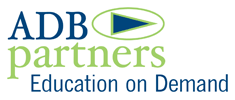To design quality unified learning, defined as aligned in-person and online professional development, associations and other learning organizations should answer three strategic questions for strategic planning. These questions guide an organization dive into the data, operations, vision. The results will help shape a data-driven plan for designing in-person and eLearning that are unified and aligned.
Even as an organization answers these three strategic questions, other queries will emerge. Thus, today’s strategic planning model is iterative and responsive to the findings and results. Such responsive and iterative planning has been explained well in Leaving ADDIE for SAM by Michael Allen.
To determine strategies that are needed and have potential to create sustainable in-person and eLearning, start with these three questions:
- What do data tell you?
- Do in-person and online training programs work as a team or as competitors?
- Is your professional education program set for 2025 or 2005?
What do data tell you? Today’s learning and membership organizations are swimming in data: conference registrations; exhibit booth sales; hotel room take rates; membership patterns – new, renewals, geographic locations, years in profession; continuing education enrollments; eLearning course registrations; career arcs of members; monthly financial reports; annual audits; and more. Unfortunately, many associations do not analyze the data and listen to the findings. To determine strategies that are meaningful and worthy of action, data-driven information is a non-negotiable. Both internal and external scans should be part of ongoing practices. Look for matches and mismatches. Are in-person events growing? What is the growth pattern for eLearning? What are the profiles of typical attendees? In particular, what are their professional and learning goals? Where are these members in their career arcs? Who is interested in 24/7 learning options? The questions could be almost endless, but uncovering patterns is the ultimate goal. Data from existing sources as well as external scans will reveal patterns of professional learning needs and interests. These data-driven models guide the design and development of unified learning. Without the patterns, organizations are cutting randomly across the education cloth.
Do in-person and online training programs work as a team or as competitors? In organizations where professional education began as in-person gatherings, online training usually has been an addition rather than a replacement. These organizations include associations and other longer-established learning organizations. In companies or organizations where online learning was the initial impetus for existence, in-person events may or may not be part of the mix. Even as digital seems poised to take over the world, in-person meetings still are magnets for multiple generations (Report: Millenials Value Face-to-Face Meetings More than You Think, August 2015). Actually it is the growing hunger for lifelong learning that is driving the move to more robust hybrid and blended learning models. Collaborations across functions: in-person education events, meeting planning, technology, and online learning become more important than ever. If in-person education and online training are working as competitors, this sets up a scenario with winners and losers. For effective professional development, learning organizations need deep benches of winning options and, thus teams guided by education standards, competencies, and curriculum. How would you describe your organization’s current working relationship between in-person and online learning: a team or competitors?
Is your professional education program set for 2025 or 2005? There is such an urgency to create dynamic, aligned learning across in-person and virtual platforms. Such learning in 2015 will be an interim step to the 2025 model. However, if your organization is still functioning like it’s 2005 (remember the excitement of webinar-driven services?), strategic changes must come quickly. Webinars now are a mainstay but future-forward webinars will be even more interactive with rich arrays of social media, chat, community forums and more surrounding the live training via webinar. Entire virtual conferences will be one of many choices, along side in-person options. Where are your collective sights set for professional development? Are they driven by young professionals and emerging economic trends? Professional education programs must be designed for short and long-range services and audiences. For associations, it is hard, yet important, to honor longstanding members and volunteer leaders even as up and coming professionals enter the scene. It is the latter group, however, which will be leading in 2025. Unified learning is the model that serves a learning organization today and tomorrow.
In January 2016, explore these questions and more with ADB Partners and iCohere in Unified Learning Design: Strategic Planning. This interactive, two-week online course begins on January 19, 2016; register now. Build on your organization’s education strengths to unify in-person and online learning through responsive strategic planning. Ask the hard questions. Seek sustainable answers. Take the path of unified learning and create dynamic, aligned, sustainable in-person and digital professional development.
Image by geralt via Pixabay.

